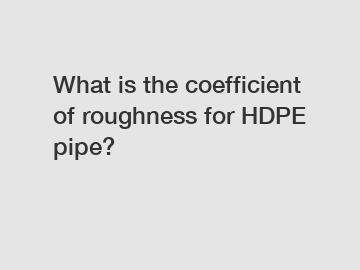What is the coefficient of roughness for HDPE pipe?
What is the coefficient of roughness for HDPE pipe?
HDPE (High-Density Polyethylene) pipes are widely used in various industries for their exceptional properties and versatility. An essential characteristic that needs consideration when designing or analyzing fluid flow in HDPE pipes is the coefficient of roughness. This coefficient determines the surface roughness of the pipe, which plays a crucial role in determining the pipe's hydraulic properties. In this article, we will explore the coefficient of roughness for HDPE pipes and its significance in fluid flow analysis.
1. Understanding the coefficient of roughness:

The coefficient of roughness, also known as the roughness factor, represents the relative measure of the pipe's internal surface roughness. It quantifies the resistance offered by the pipe's interior to the fluid flow. In the case of HDPE pipes, the coefficient of roughness determines how easily or difficultly the fluid flows through the pipe.
2. Importance of coefficient of roughness in HDPE pipe design:
The coefficient of roughness plays a vital role in designing efficient HDPE pipelines. It directly affects the frictional losses generated during fluid flow, influencing the overall flow characteristics and pressure drop. By accurately determining the coefficient of roughness, engineers can optimize pipe diameters, flow rates, and layouts, enhancing the system's performance and minimizing energy consumption.
3. Factors influencing the coefficient of roughness for HDPE pipes:
Several factors determine the coefficient of roughness for HDPE pipes, including the manufacturing process, pipe age, surface finish, and pipe dimensions. The manufacturing process and surface finish techniques significantly impact the internal surface quality, affecting the overall roughness. Additionally, as pipes age, the coefficient of roughness may change due to factors like scaling or biofilm formation.
4. Measurement methods for coefficient of roughness:
Two common methods are utilized to determine the coefficient of roughness for HDPE pipes: experimental testing and empirical correlation. Experimental testing involves directly measuring the friction factor in real-world flow conditions. While accurate, this method can be time-consuming and expensive. Empirical correlations, on the other hand, are derived from extensive experimentation and provide reliable estimates based on specific pipe dimensions and conditions.
5. Typical values for the coefficient of roughness in HDPE pipes:
The coefficient of roughness for HDPE pipes is generally low, significantly lower than that of traditional metallic pipes like steel or ductile iron. The smooth interior surface of HDPE pipes allows for efficient fluid flow with relatively low frictional losses. Depending on the specific pipe condition and age, typical values of the coefficient of roughness for HDPE pipes range from 0.0015 to 0.007 mm.
6. Influence of the coefficient of roughness on flow characteristics:
The coefficient of roughness directly affects the flow characteristics in HDPE pipes. A lower roughness factor translates to reduced frictional losses, higher flow velocities, and lower pressure drops. This feature proves advantageous in applications where energy efficiency is a priority. Moreover, the smooth interior surface of HDPE pipes minimizes the likelihood of sediment buildup, reducing the potential for flow restrictions and blockages.
7. Conclusion:
In conclusion, the coefficient of roughness for HDPE pipes plays an essential role in designing and analyzing fluid flow systems. Its influence on frictional losses, flow characteristics, and pressure drops necessitates accurate determination during the design phase. HDPE pipes, known for their smooth interior surfaces, offer reduced roughness factors compared to conventional metallic pipes. This feature contributes to improved system performance and efficiency. By understanding the coefficient of roughness and its implications, engineers and designers can optimize HDPE pipe networks for a wide range of applications, ensuring reliable and cost-effective fluid transportation.
For more information, please visit pvc vs hdpe pipe, hdpe gas piping, hdpe pipe pricing.
272
0
0

Comments
All Comments (0)